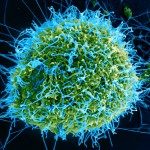Link to Pubmed [PMID] – 26437302
PLoS Negl Trop Dis 2015 Oct;9(10):e0004081
BACKGROUND: Japanese encephalitis virus (JEV) is the major cause of viral encephalitis in Southeast Asia. Vaccination of domestic pigs has been suggested as a “one health” strategy to reduce viral disease transmission to humans. The efficiency of two lentiviral TRIP/JEV vectors expressing the JEV envelope prM and E glycoproteins at eliciting protective humoral response was assessed in a mouse model and piglets.
METHODOLOGY/PRINCIPAL FINDINGS: A gene encoding the envelope proteins prM and E from a genotype 3 JEV strain was inserted into a lentiviral TRIP vector. Two lentiviral vectors TRIP/JEV were generated, each expressing the prM signal peptide followed by the prM protein and the E glycoprotein, the latter being expressed either in its native form or lacking its two C-terminal transmembrane domains. In vitro transduction of cells with the TRIP/JEV vector expressing the native prM and E resulted in the efficient secretion of virus-like particles of Japanese encephalitis virus. Immunization of BALB/c mice with TRIP/JEV vectors resulted in the production of IgGs against Japanese encephalitis virus, and the injection of a second dose one month after the prime injection greatly boosted antibody titers. The TRIP/JEV vectors elicited neutralizing antibodies against JEV strains belonging to genotypes 1, 3, and 5. Immunization of piglets with two doses of the lentiviral vector expressing JEV virus-like particles led to high titers of anti-JEV antibodies, that had efficient neutralizing activity regardless of the JEV genotype tested.
CONCLUSIONS/SIGNIFICANCE: Immunization of pigs with the lentiviral vector expressing JEV virus-like particles is particularly efficient to prime antigen-specific humoral immunity and trigger neutralizing antibody responses against JEV genotypes 1, 3, and 5. The titers of neutralizing antibodies elicited by the TRIP/JEV vector are sufficient to confer protection in domestic pigs against different genotypes of JEV and this could be of a great utility in endemic regions where more than one genotype is circulating.

